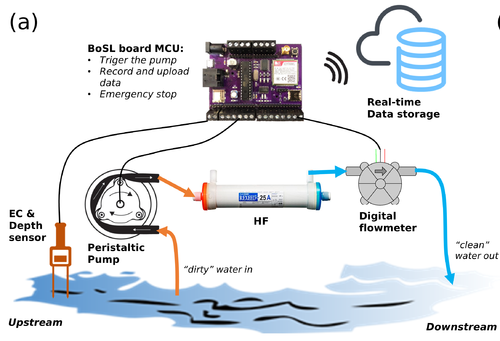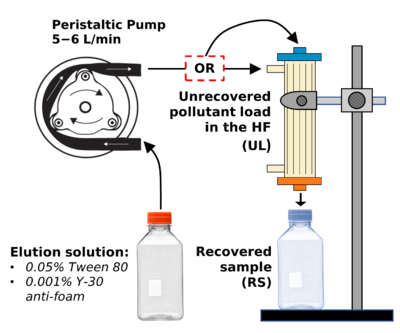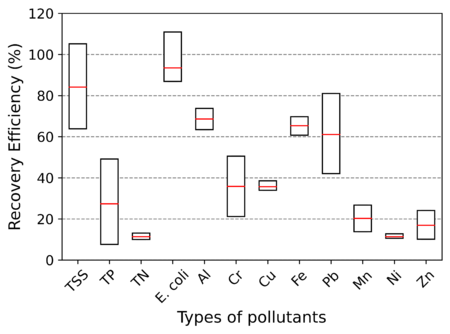Difference between revisions of "Hemo Sampler"
| Line 2: | Line 2: | ||
[[File:Concept.png|thumb|500px|right|the schematic drawing of Hemoflow Sampler for surface water sampling]] | [[File:Concept.png|thumb|500px|right|the schematic drawing of Hemoflow Sampler for surface water sampling]] | ||
| − | The Hemoflow (HF, also known as the Dead End Ultrafiltration) sampler is a large-volume sampling technique that filter the water, capture the pollutants in its cartridge, and release the clean water back to the environment. Once the filtration is completed, the captured pollutant loads are then determined by backwashing elution solution through the cartridge and store in a sample bottle, which is followed by chemical and microbiological assays. The method was originally developed for recovering microbes and viruses from potable water, but it has also been used on riverine flows with variable turbidity levels. The DEUF approach shows the following key advantages for water pollution indicator monitoring: (1) it can filter and concentrate more than hundreds of litres of water, so with a pre-determined flow rate, the sampling process could capture all flows in a day; (2) when the site has very short discharge pulses (potentially highly polluted) with a large volume of baseflow (low pollution level), the DEUF with large-volume filtration could still concentrate sufficient amount of particles or microbes; and (3) the field real-time pollution concentration forms as part of the lab assay processes, which reduce the amount of work and labour required for sample analyses.< | + | The Hemoflow (HF, also known as the Dead End Ultrafiltration) sampler is a large-volume sampling technique that filter the water, capture the pollutants in its cartridge, and release the clean water back to the environment. Once the filtration is completed, the captured pollutant loads are then determined by backwashing elution solution through the cartridge and store in a sample bottle, which is followed by chemical and microbiological assays. The method was originally developed for recovering microbes and viruses from potable water, but it has also been used on riverine flows with variable turbidity levels. The DEUF approach shows the following key advantages for water pollution indicator monitoring: (1) it can filter and concentrate more than hundreds of litres of water, so with a pre-determined flow rate, the sampling process could capture all flows in a day; (2) when the site has very short discharge pulses (potentially highly polluted) with a large volume of baseflow (low pollution level), the DEUF with large-volume filtration could still concentrate sufficient amount of particles or microbes; and (3) the field real-time pollution concentration forms as part of the lab assay processes, which reduce the amount of work and labour required for sample analyses.<br> |
| + | Asahi Kasei REXEED 25S (polysulfone, 2.5 m2 filter area and ~30 kDa pore size − Asahi KASEI (2018)) was used because previous studies found it to be the best performing ultrafilter for turbid samples. Furthermore, compared to other available DEUF, the REXEED 25S has the largest total filter area, which makes it more suitable for stormwater and wastewater due to their potential higher turbidity levels than groundwater and drinking water where the DEUF was conventionally used for. <br> | ||
In order to achieve the large-volume sampling in-situ, the HF cartridge and a small peristaltic pumping unit are included in a portable sampler kit, together with our [[BoSL Board v0.3|BoSL board]], [[BoSL Probe No1|a low-cost water depth, temperature and electrical conductivity (EC) sensor]], and a digital flow meter (USN-HS06PA-1, measuring range: 0.1−1.5 L/min). By integrating the low-cost sensor and flow meter into this HF sampler design, we make the sampling processes smarter: | In order to achieve the large-volume sampling in-situ, the HF cartridge and a small peristaltic pumping unit are included in a portable sampler kit, together with our [[BoSL Board v0.3|BoSL board]], [[BoSL Probe No1|a low-cost water depth, temperature and electrical conductivity (EC) sensor]], and a digital flow meter (USN-HS06PA-1, measuring range: 0.1−1.5 L/min). By integrating the low-cost sensor and flow meter into this HF sampler design, we make the sampling processes smarter: | ||
| Line 12: | Line 13: | ||
= How to quantify the pollution level from the HF = | = How to quantify the pollution level from the HF = | ||
| − | [[File: | + | After the water is filtered through the hemoflow, targeted pollutants, including sediments and microbes, will be captured inside the HF cartridge. In order to successfully quantify the loads and concentrations, the captured pollutants need to be backflushed from the cartridge into a sample bottle for further analysis. This backwashing process is described in the figure below. The HF will be re-positioned vertically on a bench (blue outflow port facing up and orange inflow port facing down) and held by the utility clamp with a ring stand. A peristaltic pump with 10mm silicon tubing and a high pumping rate (5-6 L/min) was utilised to backwash the pollutants out of the HF. For the elution solution, 0.05% Tween 80 and 0.001% Y-30 Antifoam are selected. The 0.01 M phosphate-buffered saline (PBS) is not recommended since we will always elute the sample straight after the sample collection, and the high phosphorus level in the PBS will affect the quantification of TP levels from the water sample. Based on our lab test results, the backwashing process should be undertaken by switching the port between the side cap and the top cap on the outflow side (orange cap), each time with a flush of 100mL elution solution. In total, only 1L of the elution solution is required. |
| + | |||
| + | [[File:Filtering.png|400px|Schematics of the DEUF setup for backwashing process to elute the concentrated pollutants into a sample bottle for further processing]] | ||
| + | |||
| + | The figure below shows the recovery efficiency of different targeted pollutants when the proposed backwashing approach is used. The results indicate that the HF can reliably recover 65% to 105% of TSS and 90% to 110% of E. coli from urban stormwater. For heavy metals that are highly associated with particles, including aluminium, iron, and lead, the HF also achieves sound recoveries between 45% and 75%. For other pollutants, including nutrients (TP and TN) and highly dissolved heavy metals (Cr, Cu, Mn, Ni, and Zn), the HF recovers less than 40% of the total pollutant load. The recovery efficiency highly depends on the dissolved-particulate proportion of the source water. In conclusion, the HF approach works very well for recovering particulate pollutants, and should not be considered as the approach for detecting highly dissolved pollutants. | ||
| + | |||
| + | [[File:Recovery efficiency.png|450px]] | ||
| + | |||
| + | = Field installation for urban stormwater dry weather discharges= | ||
XXX </p> | XXX </p> | ||
Latest revision as of 10:05, 18 June 2022
What is Hemoflow (HF) Sampler?
The Hemoflow (HF, also known as the Dead End Ultrafiltration) sampler is a large-volume sampling technique that filter the water, capture the pollutants in its cartridge, and release the clean water back to the environment. Once the filtration is completed, the captured pollutant loads are then determined by backwashing elution solution through the cartridge and store in a sample bottle, which is followed by chemical and microbiological assays. The method was originally developed for recovering microbes and viruses from potable water, but it has also been used on riverine flows with variable turbidity levels. The DEUF approach shows the following key advantages for water pollution indicator monitoring: (1) it can filter and concentrate more than hundreds of litres of water, so with a pre-determined flow rate, the sampling process could capture all flows in a day; (2) when the site has very short discharge pulses (potentially highly polluted) with a large volume of baseflow (low pollution level), the DEUF with large-volume filtration could still concentrate sufficient amount of particles or microbes; and (3) the field real-time pollution concentration forms as part of the lab assay processes, which reduce the amount of work and labour required for sample analyses.
Asahi Kasei REXEED 25S (polysulfone, 2.5 m2 filter area and ~30 kDa pore size − Asahi KASEI (2018)) was used because previous studies found it to be the best performing ultrafilter for turbid samples. Furthermore, compared to other available DEUF, the REXEED 25S has the largest total filter area, which makes it more suitable for stormwater and wastewater due to their potential higher turbidity levels than groundwater and drinking water where the DEUF was conventionally used for.
In order to achieve the large-volume sampling in-situ, the HF cartridge and a small peristaltic pumping unit are included in a portable sampler kit, together with our BoSL board, a low-cost water depth, temperature and electrical conductivity (EC) sensor, and a digital flow meter (USN-HS06PA-1, measuring range: 0.1−1.5 L/min). By integrating the low-cost sensor and flow meter into this HF sampler design, we make the sampling processes smarter:
- the pumping process can be automatically turned on and off based on the sensor's readings (i.e., only pump when water is detected)
- the sampling process could be upgraded to flow-based if the flow rate can be estimated
- when the flowmeter detects low flow rates, stop the sampling process to avoid air pressure build-up inside the cartridge
- real-time data communication to record the start and stop time, and the sampling volume
How to quantify the pollution level from the HF
After the water is filtered through the hemoflow, targeted pollutants, including sediments and microbes, will be captured inside the HF cartridge. In order to successfully quantify the loads and concentrations, the captured pollutants need to be backflushed from the cartridge into a sample bottle for further analysis. This backwashing process is described in the figure below. The HF will be re-positioned vertically on a bench (blue outflow port facing up and orange inflow port facing down) and held by the utility clamp with a ring stand. A peristaltic pump with 10mm silicon tubing and a high pumping rate (5-6 L/min) was utilised to backwash the pollutants out of the HF. For the elution solution, 0.05% Tween 80 and 0.001% Y-30 Antifoam are selected. The 0.01 M phosphate-buffered saline (PBS) is not recommended since we will always elute the sample straight after the sample collection, and the high phosphorus level in the PBS will affect the quantification of TP levels from the water sample. Based on our lab test results, the backwashing process should be undertaken by switching the port between the side cap and the top cap on the outflow side (orange cap), each time with a flush of 100mL elution solution. In total, only 1L of the elution solution is required.
The figure below shows the recovery efficiency of different targeted pollutants when the proposed backwashing approach is used. The results indicate that the HF can reliably recover 65% to 105% of TSS and 90% to 110% of E. coli from urban stormwater. For heavy metals that are highly associated with particles, including aluminium, iron, and lead, the HF also achieves sound recoveries between 45% and 75%. For other pollutants, including nutrients (TP and TN) and highly dissolved heavy metals (Cr, Cu, Mn, Ni, and Zn), the HF recovers less than 40% of the total pollutant load. The recovery efficiency highly depends on the dissolved-particulate proportion of the source water. In conclusion, the HF approach works very well for recovering particulate pollutants, and should not be considered as the approach for detecting highly dissolved pollutants.
Field installation for urban stormwater dry weather discharges
XXX


